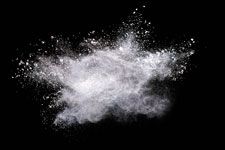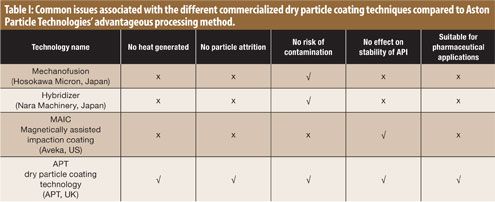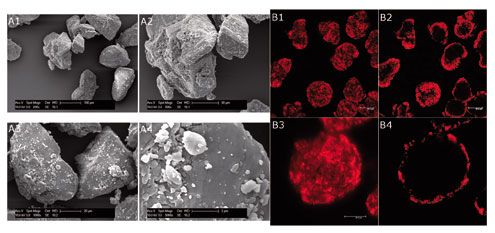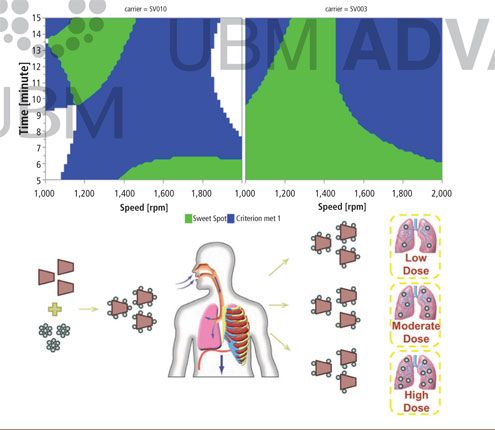Dry Particle Coating—A Unique Solution for Pharmaceutical Formulation
Aston Particle Technologies has developed a technology that produces functionalized particles in a one-step, environmentally friendly process.
piyaphong/shutterstock.com

Particle surface modification is becoming a vital strategy in the pharmaceutical industry for “difficult to formulate” APIs. Most surface modification techniques, however, alter innate particle properties either chemically or physically. These surface modification technologies involve the use of elevated temperatures, high pressures, and/or solvents, making these processes highly unsuitable for unstable APIs that are degraded when exposed to such conditions.
Aston Particle Technologies (APT) has developed the world’s first aerosolized dry particle coating technology. This technology is a one-step, ambient temperature process, with controlled processing parameters that can deliver repeatable product performance with commercially available excipients.
The science underpinning this technology requires the use of a high G-force chamber, with a curtain of nitrogen gas to fluidize the powder at the chamber wall, which disperses any agglomerated fine or coarse particles. The co-aerosolization of the particles results in coating of all the fine particles onto the surface of the coarse particles and can produce particles with designed functionalities, even with highly sensitive APIs. These functionalized particles enhance the inherent properties of API without degrading them in any way. There is no exposure to heat/solvent, and the particles suffer no attrition during processing, which is a significant advantage compared with other current state-of-the-art dry coating technologies (1-5) (see Table I).
CLICK TO ENLARGE IMAGE.

The difference in this technology is that blending occurs through particle-particle interaction in the aerosolized state compared to traditional solid-solid interactions of technologies such as high-shear blending. The intimate contact of “clouds” of individual particles facilitates the attachment of all the fine particles onto the surface of the coarse particles without causing undesirable physical/chemical modification to the constituent particles.
Dry coating principle
The principle of dry coating with APT’s technology arises from the difference in particle size between the host and carrier. Under normal mixing of a binary blend of fine and coarse particles, the fine particles display high levels of cohesivity, which can lead to the formation of agglomerates or to segregation, producing non-homogeneous mixes in an “interactive mix” (3, 4, 6-9). Dry particle coating overcomes the high cohesive forces associated with the fine “guest” particles with the fines becoming uniformly bound to surface of coarse “host” particles by strong forces of adhesion. This principle holds true as long as the size difference between the guest and carrier particles is at least double. Coating occurs because the forces of attraction between fine and coarse are greater than the weight of the fine particle itself (3, 4, 6, 10-12).
Dry coating using the technology can be depicted in three primary stages (Figure 1), which occur simultaneously: firstly, the dispersion of all the agglomerates of both the fine and coarse particles through application of the high G-force generated by revolving the processing chamber at high speed, balanced by the injection of nitrogen gas into the chamber; secondly, the dispersal of the fine particles around the coarse particles; and finally, the attachment/adhesion of the fine particles to the surface of the host, reaching a uniform spatial distribution of the fine particles.
[CLICK IMAGE TO ENLARGE] Figure 1. This schematic highlights the key steps in Aston Particle Technologies' unique dry coating process where the processes occur in parallel and allow the new composite particles to be formed. Process parameters define the extent of coating and can be controlled to produce powders with key quality attributes.

Coating examples
Powders generated by APT’s dry coater at both laboratory and pilot scale have demonstrated proof of concept for various formulation applications, including blends for dry powder inhalers (DPI), API solubility enhancement, and modification of dissolution rate. Scanning electron microscopy (SEM) and confocal laser scanning microscopy (CLSM) images of the coarse host particles loaded with the fine guest material are shown in Figure 2.
Figure 2: Scanning electron microscopy (SEM) and confocal microscopy images indicate proof of concept of dry coating. A1 to A4 show deagglomeration of the fine particles and adherence to the surface of the carrier. A1 and A2 show no fines in the field of view, indicating they are all attached to the carrier. B1 to B4 highlight confocal results whereby a fluorescent guest has been coated on to non-fluorescent microcrystalline cellulose (MCC); clear coating is observed on B1 and B3 with cross sectional images showing adsorption of the carrier to the surface of the MCC with the dark area highlighting the non-fluorescent core of the particle.

The SEM micrographs show that the fine de-agglomerated guest material is coating the coarse carrier as individual particles. These images also show that there is no free or unbound fine material and that the host particles appear to have mopped up all the available fines in the field of view.
Additionally, the CLSM micrographs confirm that the larger particles can be completely dry coated with finer material using APT’s dry coating technology. In the case shown in Figure 2, micronized, fluorescent rhodamine particles have been dry coated onto non-fluorescent microcrystalline cellulose (MCC). The cross-sectional images demonstrate that the microfine rhodamine particles form a coherent coating on the surface of the MCC host.
Blend investigations demonstrate that this dry coating principle can generate highly ordered blends, using different APIs and excipients, with reproducibly tight content uniformities. Even at concentrations as low as 0.5% w/w, the relative standard deviation (RSD) is consistently <2% with good API recovery of typically >98% (see Figure 3A).
[CLICK TO ENLARGE] Figure 3. A) Content uniformity of blends containing model drug at concentrations ranging from 0.5-10%, all showing relative standard deviation (RSD) of <2% and recovery more than 98%. B) Process parameters of the dry coating technology can be controlled to deliver various fine particle fraction (FPF) of model drug using the same formulation recipe.

Applications in lung delivery
For consistent dose performance, the pharmaceutical industry typically requires blend concentration RSD to be <6% (13). This requirement is particularly crucial for inhaled formulations in which the therapeutic dose is often in the microgram range. Through optimized process development, a platform for the application of the technology to a DPI formulation has been registered as APT-Hale.
The controlled nature of the APT-Hale process for DPIs leads to consistent API delivery, which means that the technology also determines the dosing performance of the formulated blend. The technology produces tight content uniformity and can also be tuned to deliver a particular fine particle fraction (FPF) as demonstrated in Figure 3B, where a single-blend formula processed in a designed set of experiments has been “dialed up” to deliver increasing FPF. The strength of adhesion between the fine and coarse particles can be controlled, thereby determining the amount of API that will detach from the carrier when tested in the Next Generation Impactor. Because the blends carry little or no electrostatic charge, they can be handled immediately after processing and require no conditioning or quarantine period.
To demonstrate the potential of the technology in respiratory medicine development and manufacture, a series of designed experiments, using a QbD approach, has been completed with two different, commercially sourced lactose carriers. The object of these experiments was to optimize an API/lactose formulation based on key critical quality attributes. Optimizing time and rotation speed of the blending process, which were identified as critical process parameters, demonstrated that the carrier influences the processability of the formulation (see Figure 4). The resultant design space enables the formulator to visualize a manufacturing control space for a formulation using either carrier.
Figure 4. Quality by design (QbD) sweet spot for two different carriers used in dry powder inhaler (DPI) formulation. Optimal ranges of the critical process parameters are shown for the desired profile of critical quality attributes (relative standard deviation 0-5% and fine particle fraction 25-50 mcg). The ability of the dry particle coating technology to control process outputs opens the possibility of altering process parameters to deliver multiple doses using the same formulation recipe.

Future work
Although many of these experiments were carried out at laboratory scale, APT recently collaborated with the automation engineering team at GB Innomech, which has designed and developed a system to scale up the technology 100-fold. The system has been designed so that operators can quickly access and store the required process conditions for specific production batches. Operational qualification at this pilot scale is ongoing but the process is proving to be completely scalable.
References
1. Q. Zhou et al., International Journal of Pharmaceutics, 413 (1) 36-43 (2011).
2. Q.T. Zhou et al., European Journal of Pharmaceutical Sciences, 40 (5) 412-421 (2010).
3. T. Ishizaka et al., Chem Pharm Bull, 36 (7) 2562-9 (1988).
4. T. Ishizaka et al., J Pharm Pharmacol, 41 (6) 361-8 (1989).
5. L.E. Beach, Effect of Dry Particle Coating on the Properties of Cohesive Pharmaceutical Powders, Dissertation, Otto H. York Department of Chemical, Biological and Pharmaceutical Engineering (New Jersey Institute of Technology: New Jersey, May 2011).
6. E.Z. Dahmash and A.R. Mohammed, Expert Opinion Drug Delivery, 12 (12) 1867-1879 (2015).
7. J.A. Hersey, Powder Technology, 11 (1) 41-44 (1975).
8. C.W. Yip and J.A. Hersey, Powder Technology, 16 (2) 189-192 (1977).
9. H. Honda et al., Colloids and Surfaces A: Physicochemical and Engineering Aspects, 82 (2) 117-128 (1994).
10. R. Pfeffer et al., Powder Technology, 117 (1-2) 40-67 (2001).
11. V.A. Saharan and P.K. Choudhury, Acta Pharm, 61 (3) 323-34 (2011).
12. L.J. Jallo et al., International Journal of Pharmaceutics, 423 (2) 213-225 (2012).
13. USP 40-NF 35 (United States Pharmacopoeial Convention, Rockville, MD,
2017).
Article Details
Pharmaceutical Technology
Vol. 42, No. 3
March 2018
Pages: 26â30
Citation
When referring to this article, please cite it as J. S. Koner, et. al, "Dry Particle Coating-A Unique Solution for Pharmaceutical Formulation," Pharmaceutical Technology 42 (3) 2018.
About the Authors
Jasdip S. Koner is senior formulation scientist; Eman Z. Dahmash is chief scientific officer; David A. Wyatt is chief operating officer; and *Afzal Mohammed is chief technical officer, a.u.r.mohammed@aston.ac.uk, all at Aston Particle Technologies Ltd., Aston University, Birmingham, United Kingdom. Afzal Mohammed is also a professor and chair in pharmaceutics at Aston Pharmacy School, Aston University, Birmingham, United Kingdom.
*To whom all correspondence should be addressed.

Drug Solutions Podcast: A Closer Look at mRNA in Oncology and Vaccines
April 30th 2024In this episode fo the Drug Solutions Podcast, etherna’s vice-president of Technology and Innovation, Stefaan De Koker, discusses the merits and challenges of using mRNA as the foundation for therapeutics in oncology as well as for vaccines.
Drug Solutions Podcast: Applying Appropriate Analytics to Drug Development
March 26th 2024In this episode of the Drug Solutions Podcast, Jan Bekker, Vice President of Business Development, Commercial and Technical Operations at BioCina, discusses the latest analytical tools and their applications in the drug development market.